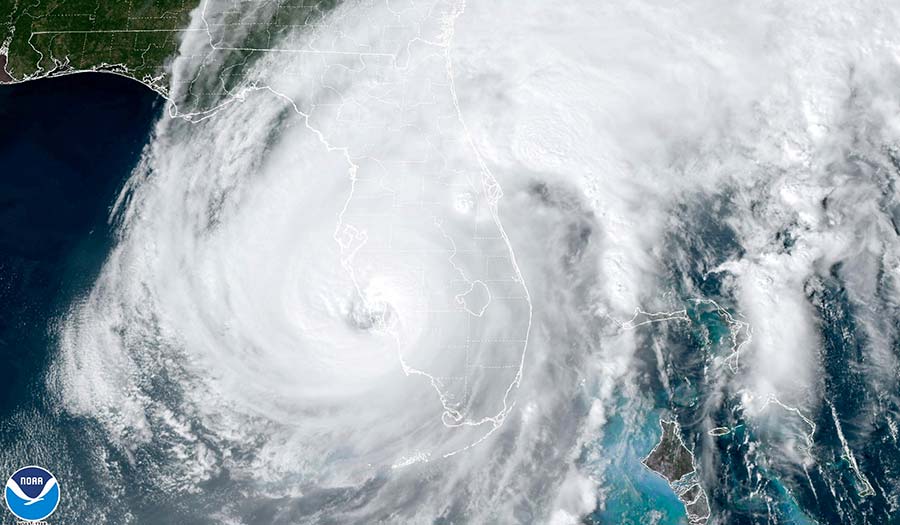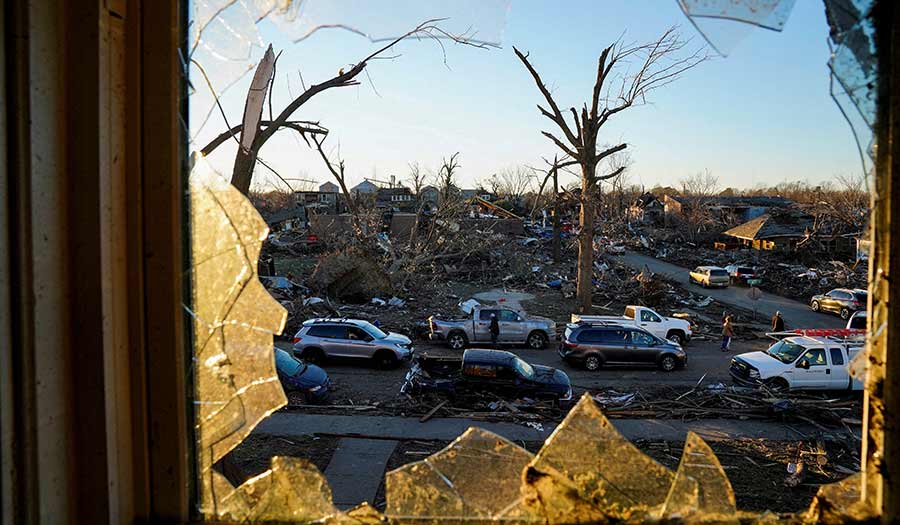 NOAA via AP
NOAA via AP
World News Desk
Learn the why behind the headlines.
Subscribe to the Real Truth for FREE news and analysis.
Subscribe NowST. PETERSBURG, Florida (AP) – Hurricane Ian destroyed a cross-section of Florida, trapping people in flooded homes, forcing patients from nursing homes and hospitals, cutting off a popular barrier island and obliterating a historic waterfront pier. Nearly 2.7 million people lost power as rain fell and waters rose.
Floodwaters rose waist-high near Orlando, far inland, as one of the strongest hurricanes to ever hit the United States crossed the peninsula. Ian’s tropical-storm-force winds extended outward up to 415 miles, drenching much of Florida and the southeastern Atlantic coast.
“It crushed us,” Lee County Sheriff Carmine Marceno told ABC’s “Good Morning America.” He said roads and bridges remained impassable, stranding thousands in the county where Ian made landfall just north of Fort Myers. “We still cannot access many of the people that are in need.”
Authorities confirmed at least one storm death in Florida—a 72-year-old man in Deltona who fell into a canal while using a hose to drain his pool in the heavy rain, the Volusia County Sheriff’s Office said. Two people died in Cuba after Ian struck there.
Mr. Marceno said that while he lacked any details, he believed the death toll would be “in the hundreds.” Governor Ron DeSantis later said that toll was not confirmed and was likely an estimate based on 911 calls.
President Joe Biden formally issued a disaster declaration Thursday, and Deanne Criswell, administrator of the Federal Emergency Management Agency, said the agency is supporting search and rescue efforts. The U.S. Coast Guard also began rescues on southwest Florida’s barrier islands early Thursday, as soon as winds died down, Mr. DeSantis said.
“The Coast Guard had people who were in their attics and got saved off their rooftops,” Mr. DeSantis said. “We’ve never seen storm surge of this magnitude…The amount of water that’s been rising, and will likely continue to rise…is basically a 500-year flooding event.”
A chunk of the Sanibel Causeway fell into the sea, cutting off access to the barrier island where 6,300 people normally live. How many heeded mandatory evacuation orders before the storm surge washed over the island was not known.
South of Sanibel, towering waves destroyed the historic beachfront pier in Naples, tearing out even the pilings underneath. “Right now, there is no pier,” said Penny Taylor, a commissioner in Collier County, which includes Naples.
Emergency crews sawed through toppled trees to reach flooded homes, but with no electricity and virtually no cell service, it was impossible for many people to call for help when the surge filled their living rooms.
In Fort Myers, Valerie Bartley was terrified as her family spent desperate hours holding a dining room table against their patio door as debris slammed into their house.
“We just assumed that it was tearing our house apart,” she said. As the storm raged outside, she said her 4-year-old daughter grabbed her hand and said: “I’m scared too, but it’s going to be OK.”
Ian made landfall Wednesday near Cayo Costa, a barrier island just west of heavily populated Fort Myers, as a Category 4 hurricane with peak sustained winds of 150 mph, tying it for the fifth-strongest hurricane, when measured by wind speed, ever to strike the U.S.
Ian’s center came ashore more than 100 miles south of Tampa and St. Petersburg, sparing them their first direct hit by a major hurricane since 1921. Water drained from Tampa Bay as it approached, then returned with a surge.
The National Hurricane Center said Ian was expected to regain near-hurricane strength after emerging over Atlantic waters near Cape Canaveral, with South Carolina in its sights for a second U.S. landfall on Friday.
Ocean waters were receding after a storm surge brought destructive waves to downtown areas from Englewood to Bonita Beach, including Charlotte Harbor and Fort Myers. Cities from Orlando to Daytona Beach in northwest Florida got their turn for severe flooding before Ian moved out to sea.
Calls from people trapped in flooded homes or from worried relatives flooded 911 lines. Pleas were also posted on social media sites, some with video showing debris-covered water sloshing toward the eaves of their homes.
Brittany Hailer, a journalist in Pittsburgh, contacted rescuers about her mother in North Fort Myers, whose home was swamped by 5 feet of water.
“We don’t know when the water’s going to go down. We don’t know how they’re going to leave, their cars are totaled,” Hailer said. “Her only way out is on a boat.”
Another boat, carrying Cuban migrants, sank Wednesday in stormy weather east of Key West.
The U.S. Coast Guard initiated a search and rescue mission for 23 people and managed to find three survivors about two miles south of the Florida Keys, officials said. Four other Cubans swam to Stock Island, just east of Key West, the U.S. Border Patrol said. Air crews continued to search for possibly 20 remaining migrants.
The storm previously killed two people in Cuba, and brought down the country’s electrical grid.
- Real Truth Magazine Articles
- WEATHER & ENVIRONMENT
 Why Does God Allow Natural Disasters?
Why Does God Allow Natural Disasters?
More on Related Topics:
- With Sewage Gushing into Sea, U.S. and Mexican Border Towns Plead for Help
- Mass Fish Death in Mexico’s Chihuahua State Blamed on Severe Drought
- It Is So Hot in Mexico, Howler Monkeys Are Falling Dead from the Trees
- Too Much Water, and Not Enough: Brazil’s Flooded South Struggles to Access Basic Goods
- E-waste Is Overflowing Landfills. At One Sprawling Vietnam Market, Workers Recycle Some of It


